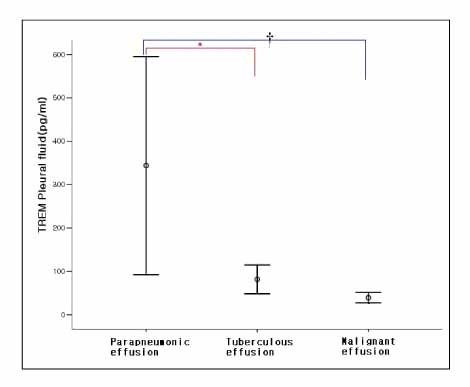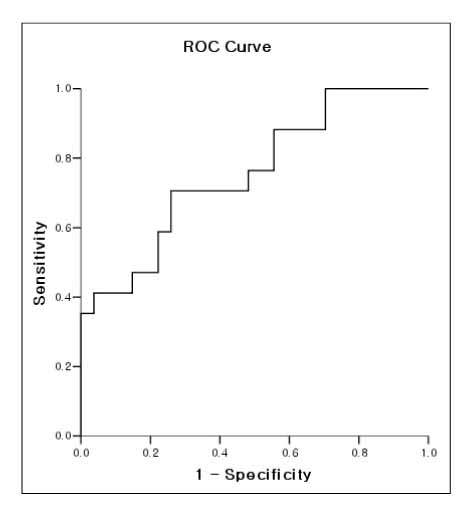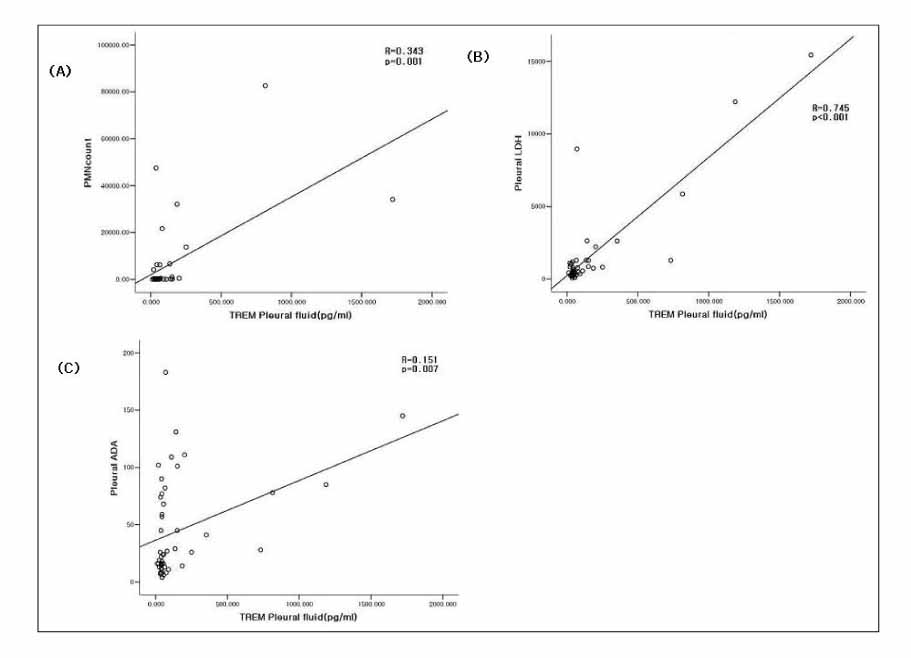Tuberc Respir Dis.
2007 Apr;62(4):290-298. 10.4046/trd.2007.62.4.290.
Soluble Triggering Receptor Expressed on Myeloid cells-1: Role in the Diagnosis of Pleural Effusions
- Affiliations
-
- 1Department of Internal Medicine, College of Medicine, Pochon CHA University, Sungnam, Korea. imekkim@cha.ac.kr
- 2Asan Life Science Institute, Asan Medical Center, Seoul, Korea.
- KMID: 1970229
- DOI: http://doi.org/10.4046/trd.2007.62.4.290
Abstract
-
BACKGROUND: The currently available diagnostic markers for pleural effusion have a limited role. The soluble triggering receptor expressed on myeloid cells-1 (sTREM-1) is a molecule recently reported to play an important role in the myeloid cell mediated inflammatory response, and is up regulated in the body fluid by bacterial or fungal products. This study examined the expression of sTREM-1 in pleural effusion.
METHODS
Between April 2004 and December 2005, 48 patients with pleural effusions were enrolled in this study. The pleural fluids were taken and analyzed for the total protein, glucose, lactate dehydrogenase (LDH), adenosine deaminase (ADA), and sTREM-1. Bacterial cultures and cytology tests were also performed.
RESULTS
The clinical diagnoses were 17 parapneumonic, 14 tuberculous, and 13 malignant effusions. Four patients presented with transudates. The mean ages of the parapneumonic, tuberculous and malignant effusion groups were 57.1+/-19.7, 49.5+/-18.6, 66.9+/-15.5, and 76.0+/-18.1. respectively. The level of sTREM-1 expression was significantly higher in the parapneumonic effusions (344.0+/-488.7) than in the tuberculous effusions (81.7+/-56.6) and malignant effusions (39.3+/-19.6). With a cut-off value of 55.4pg/ml, the sensitivity and specificity for a parapneumonic effusion was 70.6% and 74.1%.
CONCLUSION
sTREM-1 expression is significantly higher in parapneumonic effusions, suggesting its potential role as an additional diagnostic marker for pleural effusions.
MeSH Terms
Figure
Reference
-
1. Marel M, Zrustova M, Stasny B, Light RW. The incidence of pleural effusion in a well-defined region. Epidemiologic study in central Bohemia. Chest. 1993. 104:1486–1489.2. Light RW, Macgregor MI, Luchsinger PC, Ball WC Jr. Pleural effusion: the diagnostic separation of transudates and exudates. Ann Intern Med. 1972. 77:507–513.3. Romero S, Fernandez C, Arriero JM, Espasa A, Candela A, Martin C, et al. CEA, CA 15-3 and CYFRA 21-1 in serum and pleural fluid of patients with pleural effusions. Eur Respir J. 1996. 9:17–23.4. Villena V, Lopez-Encuentra A, Echave-Sustaeta J, Martin-Escribano P, Ortuno-de-Solo B, Estenoz-Alfaro J. Diagnostic value of CA 72-4, carcinoembryonic antigen, CA 15-3, and CA 19-9 assay in pleural fluid. A study of 207 patients. Cancer. 1996. 78:736–740.5. Gabay C, Kushner I. Acute-phase proteins and other systemic responses to inflammation. N Engl J Med. 1999. 340:448–454.6. Mackiewicz A, Speroff T, Ganapathi MK, Kushner I. Effect of cytokine combinations on acute phase protein production in two human hepatoma cell lines. J Immunol. 1991. 146:3032–3037.7. Grove CS, Lee YC. Vascular endothelial growth factor: the key mediator in pleural effusion formation. Curr Opin Pulm Med. 2002. 8:294–301.8. Brown LF, Detmar M, Claffey K, Nagy JA, Feng D, Dvorak AM, et al. Vascular permeability factor/vascular endothelial growth factor: a multifunctional angiogenic cytokine. EXS. 1997. 79:233–269.9. Bouchon A, Dietrich J, Colonna M. Inflammatory responses can be triggered by TREM-1, a novel receptor expressed on neutrophils and monocytes. J Immunol. 2000. 164:4991–4995.10. Bouchon A, Facchetti F, Weigand MA, Colonna M. TREM-1 amplifies inflammation and is a crucial mediator of septic shock. Nature. 2001. 410:1103–1107.11. Gibot S, Cravoisy A, Levy B, Bene MC, Faure G, Bollaert PE. Soluble triggering receptor expressed on myeloid cells and the diagnosis of pneumonia. N Engl J Med. 2004. 350:451–458.12. Richeldi L, Mariani M, Losi M, Maselli F, Corbetta L, Buonsanti C, et al. Triggering receptor expressed on myeloid cells: role in the diagnosis of lung infections. Eur Respir J. 2004. 24:247–250.13. Gibot S, Massin F, Le Renard P, Bene MC, Faure GC, Bollaert PE, et al. Surface and soluble triggering receptor expressed on myeloid cells-1: expression patterns in murine sepsis. Crit Care Med. 2005. 33:1787–1793.14. Gibot S, Kolopp-Sarda MN, Bene MC, Cravoisy A, Levy B, Faure GC, et al. Plasma level of a triggering receptor expressed on myeloid cells-1: its diagnostic accuracy in patients with suspected sepsis. Ann Intern Med. 2004. 141:9–15.15. Gibot S, Cravoisy A, Kolopp-Sarda MN, Bene MC, Faure G, Bollaert PE, et al. Time-course of sTREM (soluble triggering receptor expressed on myeloid cells)-1, procalcitonin, and C-reactive protein plasma concentrations during sepsis. Crit Care Med. 2005. 33:792–796.16. Gibot S, Le Renard PE, Bollaert PE, Kolopp-Sarda MN, Bene MC, Faure GC, et al. Surface triggering receptor expressed on myeloid cells 1 expression patterns in septic shock. Intensive Care Med. 2005. 31:594–597.17. Valdes L, San Jose E, Alvarez D, Sarandeses A, Pose A, Chomon B, et al. Diagnosis of tuberculous pleurisy using the biologic parameters adenosine deaminase, lysozyme, and interferon gamma. Chest. 1993. 103:458–465.18. Light RW. Pleural diseases. 2001. 4th ed. Philadelphia: Lippincott Williams & Wilkins.19. Maskell NA, Butland RJ. BTS guidelines for the investigation of a unilateral pleural effusion in adults. Thorax. 2003. 58:Suppl 2. ii8–ii17.20. Kim SH, Lee WY, Park JY, Park HS, Han HK, Ju HS, et al. Diagnostic value of C-reactive protein and vascular endothelial growth factor in differentiation of pleural effusions. Tuberc Respir Dis. 2003. 55:467–477.21. Bleharski JR, Kiessler V, Buonsanti C, Sieling PA, Stenger S, Colonna M, et al. A role for triggering receptor expressed on myeloid cells-1 in host defense during the early-induced and adaptive phases of the immune response. J Immunol. 2003. 170:3812–3818.22. Meisner M. Biomarkers of sepsis: clinically useful? Curr Opin Crit Care. 2005. 11:473–480.23. Romero-Candeira S, Hernandez L, Romero-Brufao S, Orts D, Fernandez C, Martin C. Is it meaningful to use biochemical parameters to discriminate between transudative and exudative pleural effusions? Chest. 2002. 122:1524–1529.24. Shin MK, Ham HS, Lee WD, Cho YJ, Jeong YY, Kim HC, et al. The diagnostic usefulness of pleural fluid adenosine deaminase with lymphocyte/neutrophil ratio in tuberculous pleural effusion. Tuberc Respir Dis. 2004. 57:132–137.25. Light RW, Girard WM, Jenkinson SG, George RB. Parapneumonic effusions. Am J Med. 1980. 69:507–512.26. Hamm H, Light RW. Parapneumonic effusion and empyema. Eur Respir J. 1997. 10:1150–1156.27. Rahman NM, Chapman SJ, Davies RJ. The approach to the patient with a parapneumonic effusion. Clin Chest Med. 2006. 27:253–266.28. Phua J, Koay ES, Zhang D, Tai LK, Boo XL, Lim KC, et al. Soluble triggering receptor expressed on myeloid cells-1 in acute respiratory infections. Eur Respir J. 2006. 28:695–702.
- Full Text Links
- Actions
-
Cited
- CITED
-
- Close
- Share
- Similar articles
-
- Diagnostic Utility of Pleural Fluid Soluble Triggering Receptor Expressed on Myeloid Cells 1 Protein in Patients with Exudative Pleural Effusion
- Soluble Interleukin-2 Receptor(sIL-2R) Levels in Patients Tuberculous Pleurisy VS Nontuberculous Pleurisy
- Comparison of Characteristics of Pleural Fluid and Blood in Mycoplasmal and Tuberculous Pleural Effusions
- Malignant Pleural Effusion: Medical Approaches for Diagnosis and Management
- Vascular endothelial growth factor in malignant and tuberculous pleural effusions





